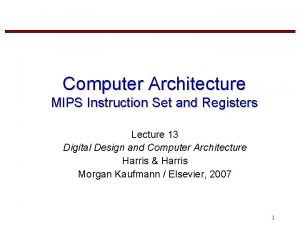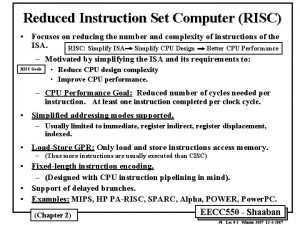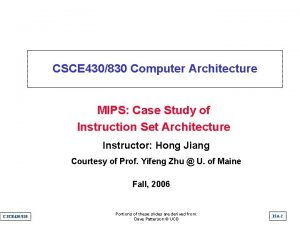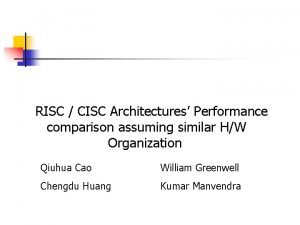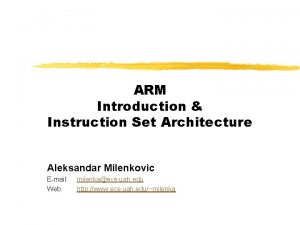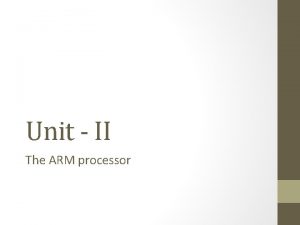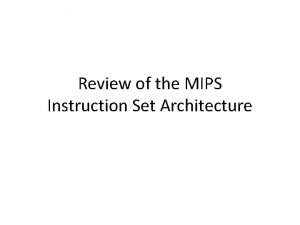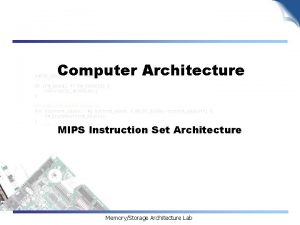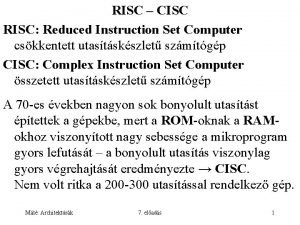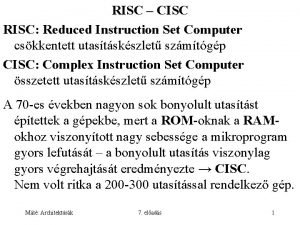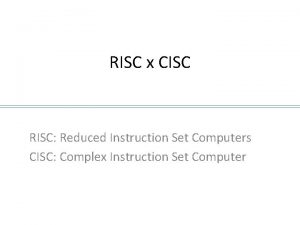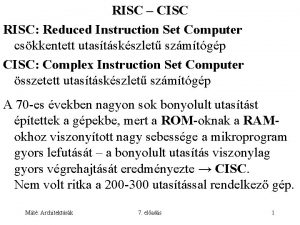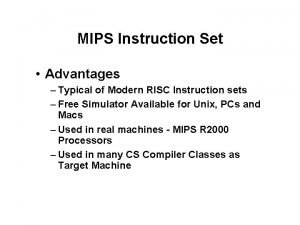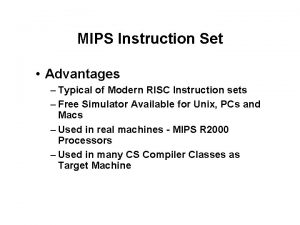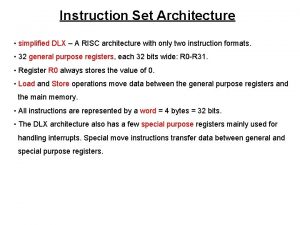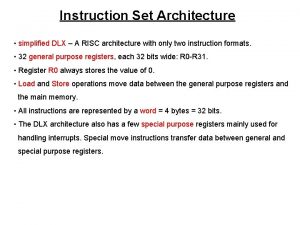Review of the MIPS Instruction Set Architecture RISC






![Instructions: load and store Example: HLL code: A[3] = h + A[3]; MIPS code: Instructions: load and store Example: HLL code: A[3] = h + A[3]; MIPS code:](https://slidetodoc.com/presentation_image_h2/96268bb01c3696e1346c1fb90e6b923a/image-7.jpg)
![Swap example C MIPS 32 swap(int v[], int k) { int temp; temp = Swap example C MIPS 32 swap(int v[], int k) { int temp; temp =](https://slidetodoc.com/presentation_image_h2/96268bb01c3696e1346c1fb90e6b923a/image-8.jpg)






- Slides: 14

Review of the MIPS Instruction Set Architecture

RISC Instruction Set Basics • All operations on data apply to data in registers and typically change the entire register • The only operations that affect memory are load and store operations • The instruction formats are few in number with all instructions typically one size • Text uses MIPS 64 – Instructions generally have a D at the start or end of the mnemonic, e. g. DADD is 64 bit ADD

MIPS ISA • 32 registers – Register 0 always has the value 0 • Three classes of instructions – ALU instructions • • Register to register or immediate to register Signed or unsigned Floating point or Integer NOT to memory – Load/Store instructions • Base register added to signed offset to get an effective address – Branches and Jumps • Branch based on condition bit or comparison between pair of registers

MIPS arithmetic • Most instructions have 3 operands • Operand order is fixed (destination first) Example: HLL code: A = B + C; MIPS code: DADD $s 0, $s 1, $s 2 ($s 0, $s 1 and $s 2 are associated with variables by compiler)

MIPS arithmetic HLL code: A = B + C + D; E = F - A; MIPS code: DADD $t 0, $s 1, $s 2 DADD $s 0, $t 0, $s 3 DSUB $s 4, $s 5, $s 0 Operands must be registers – Compiler tries to keep as many variables in registers as possible – Some variables can not be allocated • large arrays • aliased variables (variables accessible through pointers) • dynamically allocated variables on the heap or stack – Compiler may run out of registers; this is called spilling

Memory layout: Alignment 0 31 23 15 7 0 this word is aligned; the others are not address 4 8 12 16 • Words are aligned (32 bit in this example) • Big-endian or Little-endian depending on the OS
![Instructions load and store Example HLL code A3 h A3 MIPS code Instructions: load and store Example: HLL code: A[3] = h + A[3]; MIPS code:](https://slidetodoc.com/presentation_image_h2/96268bb01c3696e1346c1fb90e6b923a/image-7.jpg)
Instructions: load and store Example: HLL code: A[3] = h + A[3]; MIPS code: LW $t 0, 24($s 3) DADD $t 0, $s 2, $t 0 SW $t 0, 24($s 3) • 8 bytes per word offset to 3 rd word 24 byte displacement • h already in register $s 2 • Store word operation has no destination (reg) operand
![Swap example C MIPS 32 swapint v int k int temp temp Swap example C MIPS 32 swap(int v[], int k) { int temp; temp =](https://slidetodoc.com/presentation_image_h2/96268bb01c3696e1346c1fb90e6b923a/image-8.jpg)
Swap example C MIPS 32 swap(int v[], int k) { int temp; temp = v[k] = v[k+1]; v[k+1] = temp; } Explanation: index k : $5 base address of v: $4 address of v[k] is $4 + 4*$5 swap: MULI ADD LW LW SW SW JR $2, $15, $16, $15, $31 $5, 4 $4, $2 0($2) 4($2)

MIPS 32 Instruction Formats

Control • Decision making instructions – alter the control flow, – i. e. , change the "next" instruction to be executed • MIPS unconditional branch J Label • MIPS conditional branch instructions: BNE $t 0, $t 1, Label BEQ $t 0, $t 1, Label • Example: if (X==Y) A = B + C; BNE $s 4, $s 5, Label DADD $s 3, $s 0, $s 1 Label: . . Assembler calculates offset amount for us

Control Flow • We have: BEQ, BNE, what about Branch-if-less-than? • New instruction: meaning: if SLT $t 0, $s 1, $s 2 $s 1 < $s 2 then $t 0 = 1 else $t 0 = 0 • Can follow this with BNE $t 0, $zero, Label to get branch if less than

MIPS compiler conventions

What’s this do? 32 bits LI Foo: MULI ADD LW ADDI SW ADDI BNE $3, 4 $2, $3, 4 $2, $1, $2 $15, 0($2) $15, 1 $15, 0($2) $3, -1 $3, $zero, Foo # load immediate

Brief look at the 80 x 86 • Textbook appendix has more details • Complexity: – – Instructions from 1 to 17 bytes long one operand must act as both a source and destination one operand can come from memory complex addressing modes e. g. , “base or scaled index with 8 or 32 bit displacement” • Saving grace: – the most frequently used instructions are not too difficult to build – compilers avoid the portions of the architecture that are slow • Implementation on later processors translates x 86 instructions into RISC-like instructions internally, allowing it to adopt many of the RISC innovations
 Mips instruction set architecture
Mips instruction set architecture Zero instruction set computer
Zero instruction set computer Mips in computer architecture
Mips in computer architecture Difference between risc and cisc
Difference between risc and cisc Riscv instruction set
Riscv instruction set Marie skipcond
Marie skipcond Instruction set architecture meaning
Instruction set architecture meaning 3 stage pipeline arm organization
3 stage pipeline arm organization Which instruction set architecture is used in beaglebone?
Which instruction set architecture is used in beaglebone? Instruction set architecture
Instruction set architecture Architecture
Architecture Instruction set architecture in computer organization
Instruction set architecture in computer organization Classifying instruction set architecture
Classifying instruction set architecture Total set awareness set consideration set
Total set awareness set consideration set Training set validation set test set
Training set validation set test set
